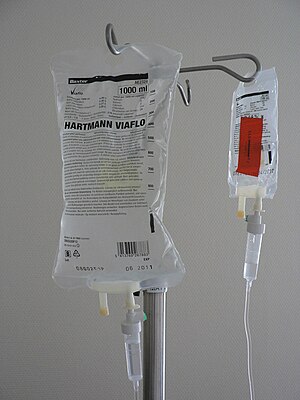 Image via Wikipedia
Image via WikipediaIn one corner, a small private practice for integrative medicine and in the other corner, a large group practice for integrative health.
Both are heavyweights in holistic treatment, but which one will be the winner? I'm being treated by doctors at both centers and after three or four rounds, so far, no knock-outs, but certainly some good punches.
Actually, I've been meaning to post this article for some time, but life has intervened. Which is a good thing because it means
I'm feeling good enough to have a life! My time is not just about going to the doctor or the acupuncturist or the physical therapist anymore. I'm writing for my local paper, going to my daughter's cheer leading competitions, visiting my son at college and going to my first college football game - tailgating and all. And of course, Mother Nature threw us a curve ball with a freak October snowstorm that knocked out our power for several days. I didn't realize how much we depend on electricity until I didn't have it - lights, heat, TV, computer, internet, phone - and in some cases even flushing the toilet! It was certainly a lesson in gratitude and I'm grateful that the power is back on so I can write and post this article.
I was reading through a sleep journal I kept last winter and I realized how far I've come. I was waking every few hours all night every night; my hot flashes were explosive; I was depressed and anxious; I was bone-tired fatigued and everything hurt. My neurotransmitters were barely registering and my adrenals were flat-lined. I was a mess! But
I have to give much of the credit to The Rothfeld Center for getting me back to some semblance of a normal life. They have been treating me aggressively since last spring and I feel like it's finally paying off. I had to wait five months to get into see the doctor at The Marino Center, so I feel like the more recent
treatment at The Marino Center has been ancillary to the treatments I've been receiving at The Rothfeld Center.
Now, a direct comparison between the approaches of
The Rothfeld Center and
The Marino Center:
Diagnosis:
When I first went to
The Rothfeld Center, I went through a battery of tests, including blood tests, spit tests, vision/neuro-toxin tests, heavy-metal tests and DNA tests. Then once those results came back, I had more blood tests to get more specific results. I must say that the labs screwed up my blood tests more than once causing me to go back for more blood draws, which was annoying and painful. Based on all that information, Dr. Rothfeld told me that I have
toxins in my body and neuro-toxins in my brain. It could have been from mold or some other toxin. Also, because of my DNA, I'm extremely vulnerable to toxins and it's harder for my body to get rid of the toxins once I have them. He also diagnosed me with
insulin resistance and
thryroid resistance syndrome. In addition,
my neurotransmitters and adrenals were shot.
When I finally got into see the doctor at
The Marino Center he was surprised that his top go-to tests for fibromyalgia had never been performed on me. I was surprised, too, given the battery of tests I had just undergone at The Rothfeld Center. I had a blood draw at the office to determine food sensitivities to 180 different foods and I took home a stool test to look for yeast in the gut. I won't go into details about the stool test but it wasn't pretty! I was glad I took both tests because they showed problems that weren't uncovered at The Rothfeld Center. The stool test showed that I had both good bacteria and
bad bacteria in my gut. It also showed that I had
candida, or yeast, in my gut, too.
Treatment:
 Image via Wikipedia
Image via WikipediaEven before my test results came back at
The Rothfeld Center, Dr. Rothfeld
put me on
magnesium-IV therapy, his go-to treatment for fibromyalgia.Once my results came back, he started me on a
no-starch diet for the insulin resistance, which means no grains or starchy vegetables. Then he put me on a
detoxification program, including a cleanse and a protocol of medications and supplements. He also put me on
several supplements to boost my neurotransmitters and support my adrenal system. For the thyroid resistance syndrome, I'm following
Wilson's T3 Protocol, using
T3 supplementation to boost my metabolism.
Once I got my stool test results back at
The Marino Center, Dr. Bordiuk was able to target my treatment. The lab had tested my sample with various anti-boitics on the bacteria and anti-fungals for the yeast so we could see which ones actually worked. I was on the
anti-biotic/anti-fungal protocol for two to three weeks. I haven't noticed a huge improvement in my symptoms, but perhaps my symptoms would have been worse had I not treated the bacteria and yeast in my gut. As for the food sensitivities, Dr. Bordiuk told me to follow the
4-Day Rotation Diet. Foods without any "stars" are fine to consume. Foods with one star can be eaten every four days. For instance, if I eat blueberries or pinto beans on Monday, I can't eat them again until Friday. Foods with two or three stars must be avoided for four months. Then I can try them again one at a time. If I have a reaction, I have to continue to avoid that food. If I don't have a reaction, I can eat that food using the 4-day rotation.
Appointments:
I've noticed a very different approach to appointments between the two centers. At
The Rothfeld Center, appointments almost always run late. However, the doctors always spend a good amount of time with me and answer all my questions. I never feel rushed. On the other hand, I have to schedule three or four hours out of my day every time I go there.
At
The Marino Center, appointments run close to on-time. I've waited up to 15 minutes but usually no longer than that. But appointments are booked every half an hour and if I'm late my appointment gets squeezed. Even when I'm on time, half an hour seems rushed and I don't always have time to get all my questions answered. On the other hand, I'm in and out of there within an hour and I have the rest of the day to live my life.
Results: Fibromyalgia is a tricky condition to treat. It's hard to tell which treatments I've received at either center have helped or not. I've seen several doctors at
The Marino Center over the years with varying success. This is the first time I've tried going to
The Rothfeld Center and so far, I think their approach is helping overall, but it's hard to pinpoint the results of specific treatments. In either case, I'm glad to have several reputable medical professionals to help me manage this life-altering condition. Now I have more than one resource to turn to when the going gets rough!






